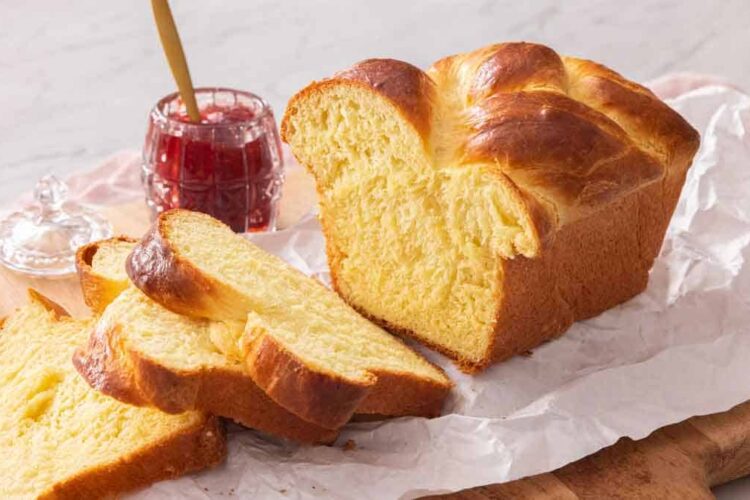Brioche Breads Recipe
Hey there, fellow bakers and bread enthusiasts! Today, we’re diving into the world of brioche, that heavenly, buttery bread that’s basically the lovechild of bread and pastry.
If you’ve ever bitten into a slice of brioche and marveled at its rich, tender crumb and subtle sweetness, you’re in for a treat.
We’re going to unravel the secrets behind making the perfect brioche right in your own kitchen. So, grab your apron, and let’s embark on this delicious adventure together!
First off, what makes brioche so special? Well, it’s all about the butter, my friends. Unlike your standard bread that might have a bit of oil or fat, brioche is enriched with a generous amount of butter.
This gives it that melt-in-your-mouth texture and a flavor that’s almost too good to be true. Originating from France (because of course it did – they know a thing or two about butter!), brioche has become a global favorite in everything from breakfast pastries to gourmet burger buns.
Now, I won’t lie to you. Making brioche is a bit of a labor of love. It takes time, patience, and a willingness to get your hands a bit messy. But trust me, when you pull that golden, glossy loaf out of the oven, you’ll feel like you’ve won the Great British Bake Off. Plus, your house will smell like a Parisian bakery. Win-win, right?
So, let’s roll up our sleeves and get into this brioche bread recipe. Here’s what you’ll need:
Ingredients:
- 4 cups all-purpose flour
- 2¼ teaspoons (1 packet) active dry yeast
- ⅓ cup granulated sugar
- 1 teaspoon salt
- ½ cup whole milk, warmed to about 110°F
- 4 large eggs, at room temperature
- 1 cup (2 sticks) unsalted butter, softened and cut into small cubes
- 1 egg yolk mixed with 1 tablespoon water for egg wash
Alright, let’s break this down step by step:
Wake Up the Yeast: Just like with our focaccia adventure, we start by activating the yeast. Mix the warm milk (think nice bath temperature, not hot tub!) with a tablespoon of the sugar and the yeast. Let it sit for about 5-10 minutes until it gets foamy. If it doesn’t foam, your yeast might be too old, or your milk too hot. Time to start over!
Mix the Dry Ingredients: In a large bowl (or the bowl of your stand mixer if you have one), whisk together the flour, remaining sugar, and salt. This ensures even distribution of sweetness and saltiness throughout your brioche.
Add the Wet Stuff: Make a well in your dry mix and add the foamy yeast mixture and the eggs. If you’re using a stand mixer with a dough hook, mix on low speed. If you’re going old school (respect!), use a wooden spoon until you get a shaggy dough.
Butter Time: Now, here’s where brioche gets its reputation. Add the butter, a few cubes at a time, while mixing on medium speed (or kneading by hand). This is a sticky business, but stick with it (pun intended). It’ll take about 10-15 minutes of mixing until the butter is fully incorporated and the dough is smooth and shiny.
First Rise: Place the dough in a greased bowl, cover with plastic wrap or a damp towel, and let it rise in a warm spot for about 1-2 hours. It won’t double like some breads because of all that butter, but it should puff up noticeably.
Chill Out: Here’s a twist – we’re going to refrigerate this dough. Why? Because all that butter makes it super soft, and chilling firms it up, making it easier to shape. Plus, a slow, cold rise deepens the flavor. So, punch down the dough (so satisfying!), re-cover it, and pop it in the fridge for at least 4 hours, but preferably overnight. Think of it as beauty sleep for your brioche!
Shape It: The next day, grease two 9-inch loaf pans. Divide your chilled dough into 12 equal pieces (a scale is handy here). Roll each piece into a ball and arrange 6 balls in each pan, like little dough buddies snuggling up together.
Second Rise: Cover the pans with a tea towel and let them rise in a warm spot for about 1½ to 2 hours. They should puff up and fill the pans. Patience is key here – don’t rush it!
Egg Wash Magic: Preheat your oven to 375°F (190°C). Gently brush the tops of your brioche with the egg wash. This is what gives it that gorgeous, glossy finish that makes everyone ooh and aah.
Bake to Golden Perfection: Bake for 30-35 minutes, until the tops are a deep golden brown and the internal temperature hits about 190°F (88°C). If the tops brown too quickly, just tent them with foil.
The Final Countdown: Let the loaves cool in the pans for about 10 minutes (I know, the waiting is torture), then turn them out onto a wire rack to cool completely. Resist the urge to slice into them immediately – letting them cool ensures that perfect texture.
And there you have it, folks! You’ve just made brioche bread. Take a moment to bask in the buttery, yeasty aroma filling your kitchen. You’re not just a baker now; you’re a brioche boss!
Now, let’s talk about how to enjoy your masterpiece. Brioche is incredibly versatile. A simple slice, lightly toasted and smeared with good butter and honey or jam, makes for a breakfast that’ll ruin you for all other breakfasts. It’s also the ultimate French toast bread – that rich, buttery flavor takes it to a whole new level.
But don’t stop at breakfast. Brioche makes killer sandwich bread. Imagine a BLT on brioche, or a grilled cheese with some fancy fromage. And let’s not forget burgers – a brioche bun elevates even the most basic patty into gourmet territory.
Got a sweet tooth? Use your brioche dough to make cinnamon rolls or babka. Or go full French and make pain au chocolat by rolling a piece of dark chocolate into each dough ball before the second rise. Trust me, it’s life-changing.
Now, what if things don’t go quite as planned? Maybe your dough is too sticky, or your loaves don’t rise as much as you’d hoped. Don’t sweat it! Baking is as much art as science. If your dough is too sticky, it might need more flour (add it gradually) or more kneading. If it’s not rising well, it could be that your yeast is old, or your kitchen is too cool. Remember, every “mistake” is a learning opportunity, and even imperfect brioche is still pretty darn delicious.
Let’s geek out a bit on the science here. The magic of brioche lies in the interplay between gluten, yeast, and fat. The gluten in the flour forms stretchy networks that trap the carbon dioxide produced by the yeast, making the bread rise. But here’s the cool part: the butter coats some of the flour proteins, limiting gluten formation. This is why brioche is tender and rich rather than chewy like a baguette.
And hey, if you’re thinking, “This sounds amazing, but I’m watching my diet,” I hear you. Brioche is definitely an indulgence. But remember, homemade is always better than store-bought because you control the ingredients. No weird additives here! You could experiment with whole wheat flour for some of the all-purpose, or try reducing the sugar slightly. It won’t be traditional brioche, but it’ll still be tasty.
One last pro tip: brioche freezes beautifully. So why not make an extra loaf? Slice it before freezing, and you can pop out individual pieces to toast as needed. Future you will be so grateful when a brioche craving hits!
In a world that’s always rushing, taking the time to make something like brioche is almost an act of rebellion. It’s choosing quality over convenience, artistry over instant gratification. Plus, there’s something deeply satisfying about mastering a traditional recipe like this. It connects you to bakers across time and cultures, all united by the love of good bread.
So, whether you’re making brioche for a special brunch, to impress your in-laws, or just because you deserve something fabulous, I hope this recipe brings you joy. Remember, it’s not just about the end product (though that’s pretty amazing). It’s about the process – the feeling of dough in your hands, the pride of creating something from scratch, and the happiness of sharing it with others.
Now, go forth and bake! Fill your home with the intoxicating aroma of freshly baked brioche. And when you bite into that first buttery, tender slice, take a moment to savor your achievement. You’re not just a baker; you’re a brioche whisperer, a butter boss, a creator of edible happiness. Bon appétit, and happy baking!

